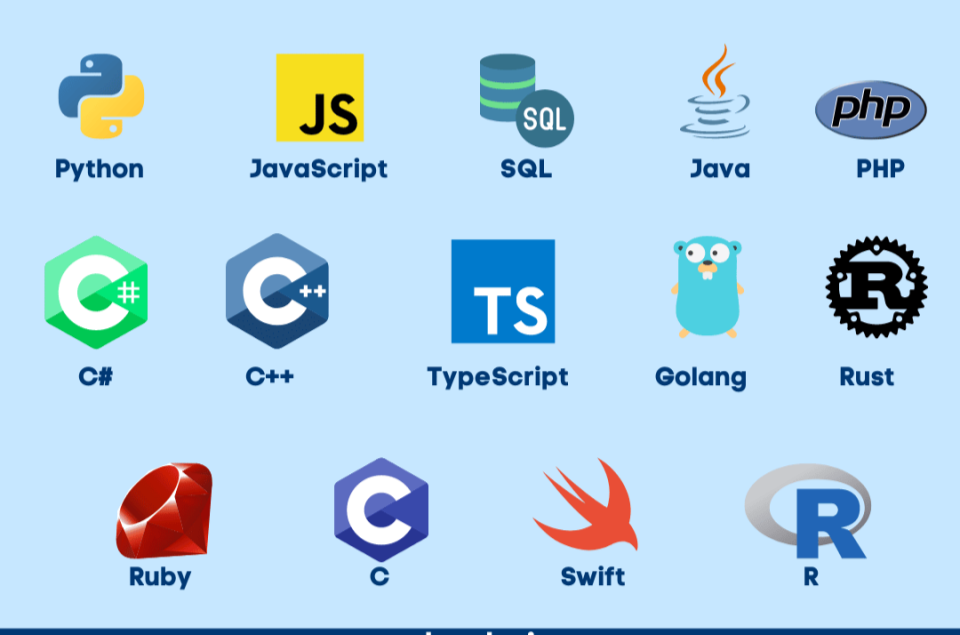Introduction
In the fast-paced tech world of 2025, programming languages shape the digital experiences we interact with daily. From artificial intelligence to mobile apps and web development, the demand for skilled developers continues to grow. But with so many languages to choose from, which ones truly stand out?
In this article, we’ve compiled a comprehensive list of the top 10 most popular programming languages in the world. This guide is perfect for developers, students, and tech professionals who want to stay ahead in their careers.
What Makes a Language Popular and Best in 2025?
Before diving into the list, let’s clarify the criteria:

1,200 × 635
- 🔥 Demand in the Job Market
- 📚 Ease of Learning and Readability
- 🌐 Community Support
- 🚀 Performance and Versatility
- 🧠 Use in Emerging Technologies (AI, ML, Blockchain)
🌟 Top 10 Best Programming Languages in the World (2025)
1. Python
Why it’s #1 in 2025:
- Easy to read and write
- Huge use in AI, ML, data science, automation, web apps
- Massive community and library support
Use Cases:
Data science, web apps (Django, Flask), automation, AI, cybersecurity
Job Demand: Very High
Learning Curve: Very Easy
🔗 External Resource: Python on Stack Overflow Developer Survey
2. JavaScript
Why it’s still essential:
- Dominates front-end development
- Enables dynamic and interactive websites
- Powers backend with Node.js
Use Cases:
Web apps (React, Vue, Angular), server-side (Node.js), PWA, games
Job Demand: Very High
Learning Curve: Easy
3. Java
Why Java holds strong:
- Enterprise-grade applications
- Huge in Android development
- Strong backward compatibility
Use Cases:
Banking software, mobile apps, enterprise apps, web servers
Job Demand: High
Learning Curve: Medium
4. C# (C-Sharp)
Why it’s trending in 2025:
- Backbone of Unity game development
- Strong in desktop and enterprise applications
Use Cases:
Game development, Windows apps, cloud services
Job Demand: High
Learning Curve: Medium
5. TypeScript
Why it matters:
- Superset of JavaScript with added safety
- Now widely adopted in large-scale web apps
Use Cases:
Modern web apps, scalable frontends, SPAs
Job Demand: High
Learning Curve: Medium
6. Go (Golang)
Why Go is rising:
- Designed by Google
- Efficient for cloud-native and server-side applications
Use Cases:
DevOps tools, microservices, cloud computing
Job Demand: Growing
Learning Curve: Medium
7. Rust
Why it’s loved by developers:
- Memory safety and performance
- Great for systems programming
Use Cases:
OS development, web assembly, game engines
Job Demand: Medium
Learning Curve: Hard
👀 Related: Rust is the most loved language on Stack Overflow
8. Kotlin
Why it’s popular:
- Official language for Android development
- Concise and safer than Java
Use Cases:
Android apps, backend development
Job Demand: Medium
Learning Curve: Medium
9. Swift
Why iOS developers swear by it:
- Official Apple language
- Optimized for speed and safety
Use Cases:
iOS, macOS apps, Apple ecosystem
Job Demand: Medium
Learning Curve: Medium
10. SQL
Why it’s still critical:
- The backbone of databases
- Required in nearly every tech stack
Use Cases:
Data querying, analytics, backend systems
Job Demand: Very High
Learning Curve: Easy
📊 Comparison Table of Top 10 Programming Languages in 2025
| Language | Difficulty | Job Demand | Best For |
|---|---|---|---|
| Python | Easy | Very High | AI, Web, Automation |
| JavaScript | Easy | Very High | Web, Mobile, Full Stack |
| Java | Medium | High | Enterprise, Android |
| C# | Medium | High | Games, Windows Apps |
| TypeScript | Medium | High | Modern Web Apps |
| Go | Medium | Growing | Microservices, Cloud |
| Rust | Hard | Medium | Systems Programming |
| Kotlin | Medium | Medium | Android |
| Swift | Medium | Medium | iOS/macOS Development |
| SQL | Easy | Very High | Databases, Analytics |
🧠 Final Thoughts
Choosing the best programming language depends on your goals. If you’re a beginner, Python or JavaScript is your safest bet. Interested in mobile development? Go with Kotlin or Swift. Want high performance and safety? Try Rust or Go.
In 2025, tech is more integrated into our lives than ever. Mastering any of these top 10 languages can give you a powerful edge in the job market and open doors to endless opportunities.
🔍 FAQ Section
Q: Which programming language has the highest salary in 2025?
A: Rust, Go, and Python developers often top salary charts globally.
Q: Which language is best for AI and data science?
A: Python is the best for AI, machine learning, and data science due to its libraries and community.
Q: Is JavaScript still worth learning in 2025?
A: Absolutely. JavaScript powers most of the modern web and shows no signs of slowing down.




